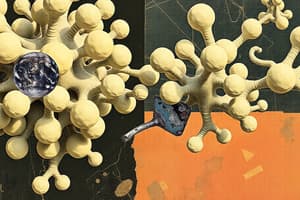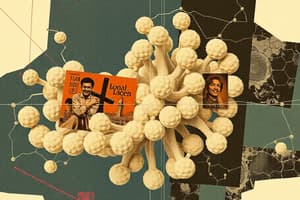Podcast
Questions and Answers
What is an important feature of globular proteins?
What is an important feature of globular proteins?
- Compact shape with rounded structure (correct)
- Exclusively enzymatic function
- Insolubility in water
- Limited biological functions
What gives the name 'heme proteins' to Myoglobin and Hemoglobin?
What gives the name 'heme proteins' to Myoglobin and Hemoglobin?
- Prosthetic group
- Heme group (correct)
- Apoprotein part
- Unique subunit
Where is Myoglobin found and what is its function?
Where is Myoglobin found and what is its function?
- In muscle; oxygen storage (correct)
- In erythrocytes; oxygen transport
- In blood plasma; immune function
- In liver; enzymatic function
What is the role of Hemoglobin in the body?
What is the role of Hemoglobin in the body?
What is the prosthetic group present in both myoglobin and hemoglobin?
What is the prosthetic group present in both myoglobin and hemoglobin?
What type of structure does hemoglobin have?
What type of structure does hemoglobin have?
What is the role of distal histidine in myoglobin and hemoglobin?
What is the role of distal histidine in myoglobin and hemoglobin?
What is the state of the iron atom in the heme group?
What is the state of the iron atom in the heme group?
What does myoglobin's hydrophobic pocket do?
What does myoglobin's hydrophobic pocket do?
What is the name of the complex organic ring structure in the heme group?
What is the name of the complex organic ring structure in the heme group?
What is the role of proximal histidine in myoglobin and hemoglobin?
What is the role of proximal histidine in myoglobin and hemoglobin?
What does the heme group allow myoglobin and hemoglobin to do?
What does the heme group allow myoglobin and hemoglobin to do?
Flashcards are hidden until you start studying
Study Notes
Globular Proteins
- Globular proteins are characterized by their compact, spherical shape, allowing them to be soluble in water.
Heme Proteins
- Myoglobin and Hemoglobin are classified as "heme proteins" due to the presence of heme, an iron-containing prosthetic group that facilitates oxygen binding.
Myoglobin
- Myoglobin is primarily located in muscle tissue, where it serves to store and transport oxygen to muscle cells.
Hemoglobin
- Hemoglobin plays a crucial role in transporting oxygen from the lungs to tissues and returns carbon dioxide from tissues back to the lungs.
Prosthetic Group
- Both Myoglobin and Hemoglobin contain the heme group as their prosthetic group, enabling oxygen binding.
Hemoglobin Structure
- Hemoglobin has a quaternary structure, composed of four peptide chains (two alpha and two beta chains), forming a tetramer.
Distal Histidine
- The distal histidine plays a significant role in stabilizing the bound oxygen molecule in both Myoglobin and Hemoglobin by facilitating the proper orientation of oxygen.
Iron State
- In the heme group, the iron atom is in the ferrous state (Fe²⁺) when it binds oxygen, allowing for reversible binding.
Hydrophobic Pocket
- Myoglobin's hydrophobic pocket is crucial for protecting the heme group from solvent interactions, ensuring stable binding and release of oxygen.
Heme Group Structure
- The heme group consists of a complex organic ring structure known as porphyrin, which houses the iron atom at its center.
Proximal Histidine
- The proximal histidine coordinates directly with the iron atom in the heme group, facilitating the binding of oxygen molecules.
Function of Heme Group
- The heme group enables both Myoglobin and Hemoglobin to bind to oxygen, critically supporting aerobic respiration in living organisms.
Studying That Suits You
Use AI to generate personalized quizzes and flashcards to suit your learning preferences.




